-
DS90CR286AT-Q1 3.3 V Rising Edge Data Strobe LVDS Receiver 28-Bit Channel Link 66 MHz
- 1 Features
- 2 Applications
- 3 Description
- 4 Revision History
- 5 Pin Configuration and Functions
- 6 Specifications
- 7 Detailed Description
- 8 Application and Implementation
- 9 Power Supply Recommendations
- 10Layout
- 11Device and Documentation Support
- 12Mechanical, Packaging, and Orderable Information
- IMPORTANT NOTICE
Package Options
Mechanical Data (Package|Pins)
- DGG|56
Thermal pad, mechanical data (Package|Pins)
Orderable Information
DS90CR286AT-Q1 3.3 V Rising Edge Data Strobe LVDS Receiver 28-Bit Channel Link 66 MHz
1 Features
- 20 to 66 MHz Shift Clock Support
- 50% Duty Cycle on Receiver Output Clock
- Best–in–Class Setup & Hold Times on Rx Outputs
- Rx Power Consumption < 270 mW (typ) at 66 MHz Worst Case
- Rx Power-down Mode < 200 μW (max)
- ESD Rating: 4 kV (HBM), 1 kV (CDM)
- PLL Requires No External Components
- Compatible with TIA/EIA-644 LVDS Standard
- Low Profile 56-Pin DGG (TSSOP) Package
- Operating Temperature: −40°C to +105°C
- Automotive AEC-Q100 Grade 2 Qualified
2 Applications
- Video Displays
- Automotive Infotainment
- Industrial Printers and Imaging
- Digital Video Transport
- Machine Vision
- OpenLDI-to-RGB Bridge
3 Description
The DS90CR286AT-Q1 receiver converts four LVDS (Low Voltage Differential Signaling) data streams back into parallel 28 bits of LVCMOS data. The receiver data outputs strobe on the output clock's rising edge.
The receiver LVDS clock operates at rates from 20 to 66 MHz. The DS90CR286AT-Q1 phase-locks to the input LVDS clock, samples the serial bit streams at the LVDS data lines, and converts them into 28-bit parallel output data. At an incoming clock rate of 66 MHz, each LVDS input line is running at a bit rate of 462 Mbps, resulting in a maximum throughput of 1.848 Gbps.
The DS90CR286AT-Q1 device is enhanced over prior generation receivers due to a wider data valid time on the receiver output. The DS90CR286AT-Q1 is designed for PCB board chip-to-chip OpenLDI-to-RGB bridge conversion. LVDS data transmission over cable interconnect is not recommended for this device.
Users designing a sub-system with a compatible OpenLDI transmitter and DS90CR286AT-Q1 receiver must ensure an acceptable skew margin budget (RSKM). Details regarding RSKM can be found in the Application Information section.
Device Information(1)
| PART NUMBER | PACKAGE | BODY SIZE (NOM) |
|---|---|---|
| DS90CR286AT-Q1 | TSSOP (56) | 14.00 mm × 6.10 mm |
- For all available packages, see the orderable addendum at the end of the data sheet.
Typical Application Block Diagram

4 Revision History
Changes from * Revision (November 2015) to A Revision
- Changed Product Preview to full datasheet Production Data releaseGo
5 Pin Configuration and Functions
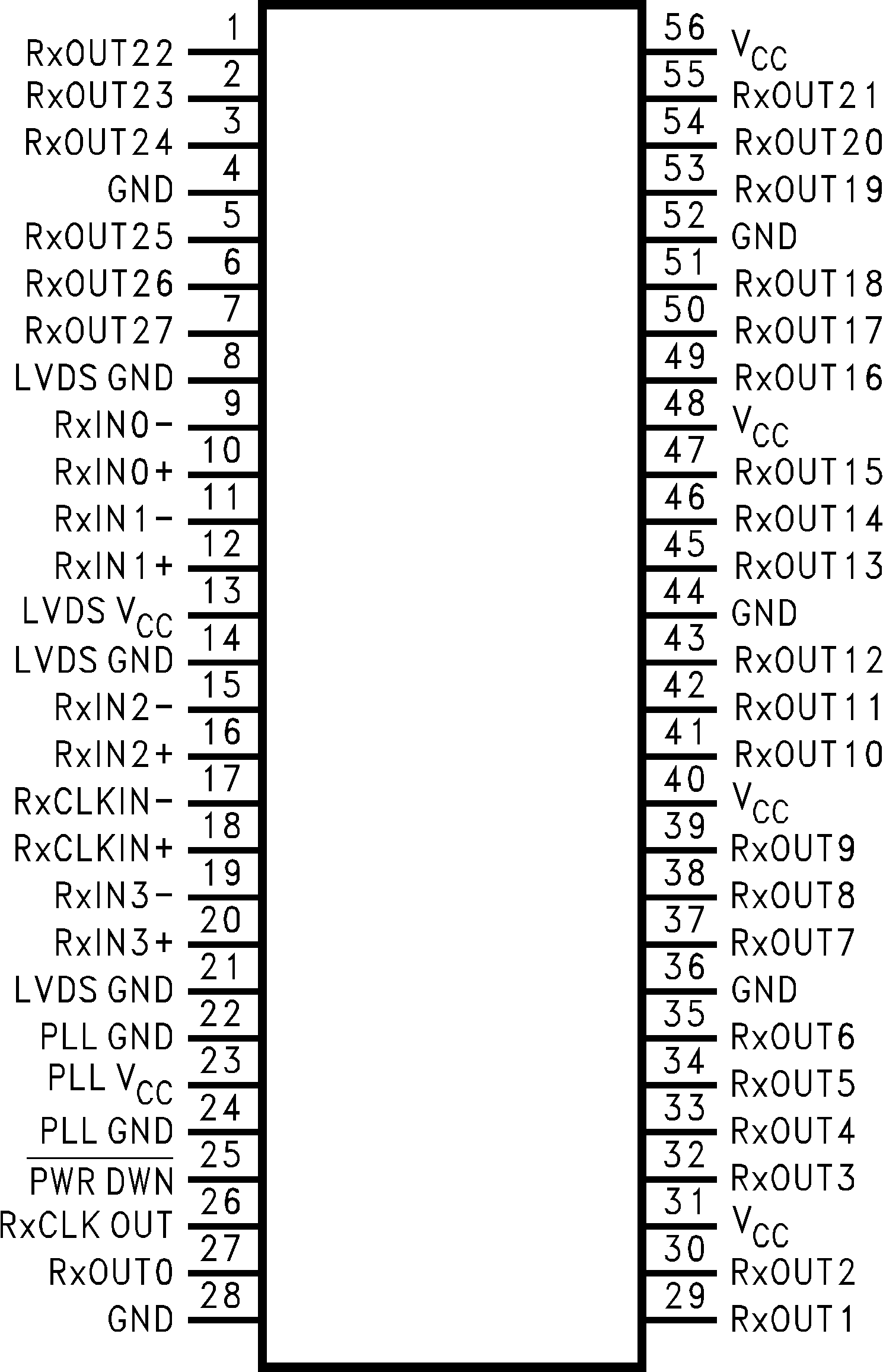
Pin Functions
| PIN | I/O , TYPE | PIN DESCRIPTION | |
|---|---|---|---|
| NAME | NO. | ||
| RxIN0+, RxIN0-, RxIN1+, RxIN1-, RxIN2+, RxIN2-, RxIN3+, RxIN3- |
10, 9, 12, 11, 16, 15, 20, 19 |
I, LVDS | Positive and negative LVDS differential data inputs. 100 Ω termination resistors should be placed between RxIN+ and RxIN- receiver inputs as close as possible to the receiver pins for proper signaling. |
| RxCLKIN+, RxCLKIN- |
18, 17 |
I, LVDS | Positive and negative LVDS differential clock input. 100 Ω termination resistor should be placed between RxCLKIN+ and RxCLKIN- receiver inputs as close as possible to the receiver pins for proper signaling. |
| RxOUT[27:0] | 7, 6, 5, 3, 2, 1, 55, 54, 53, 51, 50, 49, 47, 46, 45, 43, 42, 41, 39, 38, 37, 35, 34, 33, 32, 30, 29, 27 |
O, LVCMOS | LVCMOS level data outputs. |
| RxCLK OUT | 26 | O, LVCMOS | LVCMOS Ievel clock output. The rising edge acts as the data strobe. |
| PWR DWN | 25 | I, LVCMOS | LVCMOS level input. When asserted low, the receiver outputs are low. |
| VCC | 56, 48, 40, 31 | Power | Power supply pins for LVCMOS outputs. |
| GND | 52, 44, 36, 28, 4 |
Power | Ground pins for LVCMOS outputs. |
| PLL VCC | 23 | Power | Power supply for PLL. |
| PLL GND | 24, 22 | Power | Ground pin for PLL. |
| LVDS VCC | 13 | Power | Power supply pin for LVDS inputs. |
| LVDS GND | 21, 14, 8 | Power | Ground pins for LVDS inputs. |
6 Specifications
6.1 Absolute Maximum Ratings
over operating free-air temperature range (unless otherwise noted) (1)| MIN | MAX | UNIT | |
|---|---|---|---|
| Supply Voltage (VCC) | −0.3 | 4 | V |
| LVCMOS Output Voltage | −0.3 | (VCC + 0.3) | V |
| LVDS Receiver Input Voltage | −0.3 | (VCC + 0.3) | V |
| Operating Junction Temperature | 150 | °C | |
| Lead Temperature (Soldering, 4 sec) | 260 | °C | |
| Storage temperature, Tstg | −65 | 150 | °C |
6.2 ESD Ratings
| VALUE | UNIT | |||
|---|---|---|---|---|
| V(ESD) | Electrostatic discharge | Human-body model (HBM), per AEC Q100-002(1) | ±4000 | V |
| Charged-device model (CDM), per AEC Q100-011 | ±1000 | |||
6.3 Recommended Operating Conditions
over operating free-air temperature range (unless otherwise noted)| MIN | NOM | MAX | UNIT | ||
|---|---|---|---|---|---|
| Supply Voltage (VCC) | 3.0 | 3.3 | 3.6 | V | |
| Operating Free Air Temperature (TA) | −40 | 25 | 105 | °C | |
| Receiver Input Range | 0 | 2.4 | V | ||
| Supply Noise Voltage (VNoise) | 100 | mVp-p | |||
6.4 Thermal Information
| THERMAL METRIC(1) | DS90CR286AT-Q1 | UNIT | |
|---|---|---|---|
| DGG (TSSOP) | |||
| 56 PINS | |||
| RθJA | Junction-to-ambient thermal resistance | 64.6 | °C/W |
| RθJC(top) | Junction-to-case (top) thermal resistance | 20.6 | |
| RθJB | Junction-to-board thermal resistance | 33.3 | |
| ψJT | Junction-to-top characterization parameter | 1.0 | |
| ψJB | Junction-to-board characterization parameter | 33.0 | |
6.5 Electrical Characteristics(1)(2)
over operating free-air temperature range (unless otherwise noted)| PARAMETER | TEST CONDITIONS | MIN | TYP | MAX | UNIT | ||
|---|---|---|---|---|---|---|---|
| LVCMOS DC SPECIFICATIONS (For PWR DWN Pin) | |||||||
| VIH | High Level Input Voltage | 2.0 | VCC | V | |||
| VIL | Low Level Input Voltage | GND | 0.8 | V | |||
| VCL | Input Clamp Voltage | ICL = −18 mA | −0.79 | −1.5 | V | ||
| IIN | Input Current | VIN = 0.4 V, 2.5 V or VCC | +1.8 | +10 | μA | ||
| V IN = GND | −10 | 0 | μA | ||||
| LVCMOS DC SPECIFICATIONS | |||||||
| VOH | High Level Output Voltage | IOH = −0.4 mA | 2.7 | 3.3 | V | ||
| VOL | Low Level Output Voltage | IOL = 2 mA | 0.06 | 0.3 | V | ||
| IOS | Output Short Circuit Current | VOUT = 0 V | −60 | −120 | mA | ||
| LVDS RECEIVER DC SPECIFICATIONS | |||||||
| VTH | Differential Input High Threshold | VCM = 1.2 V | +100 | mV | |||
| VTL | Differential Input Low Threshold | VCM = 1.2 V | −100 | mV | |||
| IIN | Input Current | VIN = 2.4 V, VCC = 3.6 V | ±10 | μA | |||
| VIN = 0V , VCC = 3.6 V | ±10 | μA | |||||
| ICCRW | Receiver Supply Current Worst Case | CL = 8 pF, Worst Case Pattern, DS90CR286AT-Q1 (Figure 1 Figure 2), TA=−40°C to 105°C | f = 33 MHz | 49 | 65 | mA | |
| f = 40 MHz | 53 | 70 | mA | ||||
| f = 66 MHz | 81 | 105 | mA | ||||
| ICCRZ | Receiver Supply Current Power Down | PWR DWN = Low; Receiver Outputs Stay Low during Power Down Mode | 10 | 55 | μA | ||
6.6 Switching Characteristics
over operating free-air temperature range (unless otherwise noted)| PARAMETER | TEST CONDITIONS | MIN | TYP | MAX | UNIT | |
|---|---|---|---|---|---|---|
| CLHT | LVCMOS Low-to-High Transition Time (Figure 2) | 2 | 5 | ns | ||
| CHLT | LVCMOS High-to-Low Transition Time (Figure 2) | 1.8 | 5 | ns | ||
| RSPos0 | Receiver Input Strobe Position for Bit 0 (Figure 8) | f = 40 MHz, T = 25ºC | 1.01 | 1.4 | 2.45 | ns |
| RSPos1 | Receiver Input Strobe Position for Bit 1 | 4.52 | 5.0 | 5.99 | ns | |
| RSPos2 | Receiver Input Strobe Position for Bit 2 | 8.08 | 8.5 | 9.35 | ns | |
| RSPos3 | Receiver Input Strobe Position for Bit 3 | 11.59 | 11.9 | 12.89 | ns | |
| RSPos4 | Receiver Input Strobe Position for Bit 4 | 15.15 | 15.6 | 16.53 | ns | |
| RSPos5 | Receiver Input Strobe Position for Bit 5 | 18.86 | 19.2 | 20.20 | ns | |
| RSPos6 | Receiver Input Strobe Position for Bit 6 | 22.34 | 22.9 | 23.91 | ns | |
| RSPos0 | Receiver Input Strobe Position for Bit 0 (Figure 8) | f = 66 MHz, T = -40ºC | 0.58 | 1.1 | 1.55 | ns |
| RSPos1 | Receiver Input Strobe Position for Bit 1 | 2.77 | 3.3 | 3.80 | ns | |
| RSPos2 | Receiver Input Strobe Position for Bit 2 | 5.01 | 5.4 | 5.77 | ns | |
| RSPos3 | Receiver Input Strobe Position for Bit 3 | 7.11 | 7.5 | 7.88 | ns | |
| RSPos4 | Receiver Input Strobe Position for Bit 4 | 9.24 | 9.7 | 10.12 | ns | |
| RSPos5 | Receiver Input Strobe Position for Bit 5 | 11.44 | 11.9 | 12.32 | ns | |
| RSPos6 | Receiver Input Strobe Position for Bit 6 | 13.62 | 14.1 | 14.50 | ns | |
| RSPos0 | Receiver Input Strobe Position for Bit 0 (Figure 8) | f = 66 MHz, T = 25ºC | 0.68 | 1.2 | 1.64 | ns |
| RSPos1 | Receiver Input Strobe Position for Bit 1 | 2.88 | 3.4 | 3.88 | ns | |
| RSPos2 | Receiver Input Strobe Position for Bit 2 | 5.08 | 5.5 | 5.87 | ns | |
| RSPos3 | Receiver Input Strobe Position for Bit 3 | 7.20 | 7.6 | 7.98 | ns | |
| RSPos4 | Receiver Input Strobe Position for Bit 4 | 9.30 | 9.7 | 10.24 | ns | |
| RSPos5 | Receiver Input Strobe Position for Bit 5 | 11.50 | 12.0 | 12.40 | ns | |
| RSPos6 | Receiver Input Strobe Position for Bit 6 | 13.70 | 14.2 | 14.57 | ns | |
| RSPos0 | Receiver Input Strobe Position for Bit 0 (Figure 8) | f = 66 MHz, T = 105ºC | 0.84 | 1.3 | 1.74 | ns |
| RSPos1 | Receiver Input Strobe Position for Bit 1 | 3.00 | 3.6 | 4.05 | ns | |
| RSPos2 | Receiver Input Strobe Position for Bit 2 | 5.14 | 5.6 | 6.02 | ns | |
| RSPos3 | Receiver Input Strobe Position for Bit 3 | 7.30 | 7.8 | 8.14 | ns | |
| RSPos4 | Receiver Input Strobe Position for Bit 4 | 9.42 | 9.9 | 10.40 | ns | |
| RSPos5 | Receiver Input Strobe Position for Bit 5 | 11.59 | 12.1 | 12.57 | ns | |
| RSPos6 | Receiver Input Strobe Position for Bit 6 | 13.83 | 14.3 | 14.73 | ns | |
| RCOP | RxCLK OUT Period (Figure 3) | 15 | 50 | ns | ||
| RCOH | RxCLK OUT High Time (Figure 3) | f = 40 MHz | 10.0 | 12.2 | ns | |
| RCOL | RxCLK OUT Low Time (Figure 3) | 10.0 | 11.0 | ns | ||
| RSRC | RxOUT Setup to RxCLK OUT (Figure 3) | 6.5 | 11.6 | ns | ||
| RHRC | RxOUT Hold to RxCLK OUT (Figure 3) | 6.0 | 11.6 | ns | ||
| RCOH | RxCLK OUT High Time (Figure 3) | f = 66 MHz | 5.0 | 7.6 | ns | |
| RCOL | RxCLK OUT Low Time (Figure 3) | 5.0 | 6.3 | ns | ||
| RSRC | RxOUT Setup to RxCLK OUT (Figure 3) | 4.5 | 7.3 | ns | ||
| RHRC | RxOUT Hold to RxCLK OUT (Figure 3) | 4.0 | 6.3 | ns | ||
| RCCD | RxCLK IN to RxCLK OUT Delay at 25°C, VCC = 3.3V(1) (Figure 4) | 3.5 | 5.0 | 7.5 | ns | |
| RPLLS | Receiver Phase Lock Loop Set (Figure 5) | 10 | ms | |||
| RPDD | Receiver Power Down Delay (Figure 7) | 1 | μs | |||
 Figure 1. "Worst Case" Test Pattern
Figure 1. "Worst Case" Test Pattern
 Figure 2. LVCMOS Output Load and Transition Times
Figure 2. LVCMOS Output Load and Transition Times
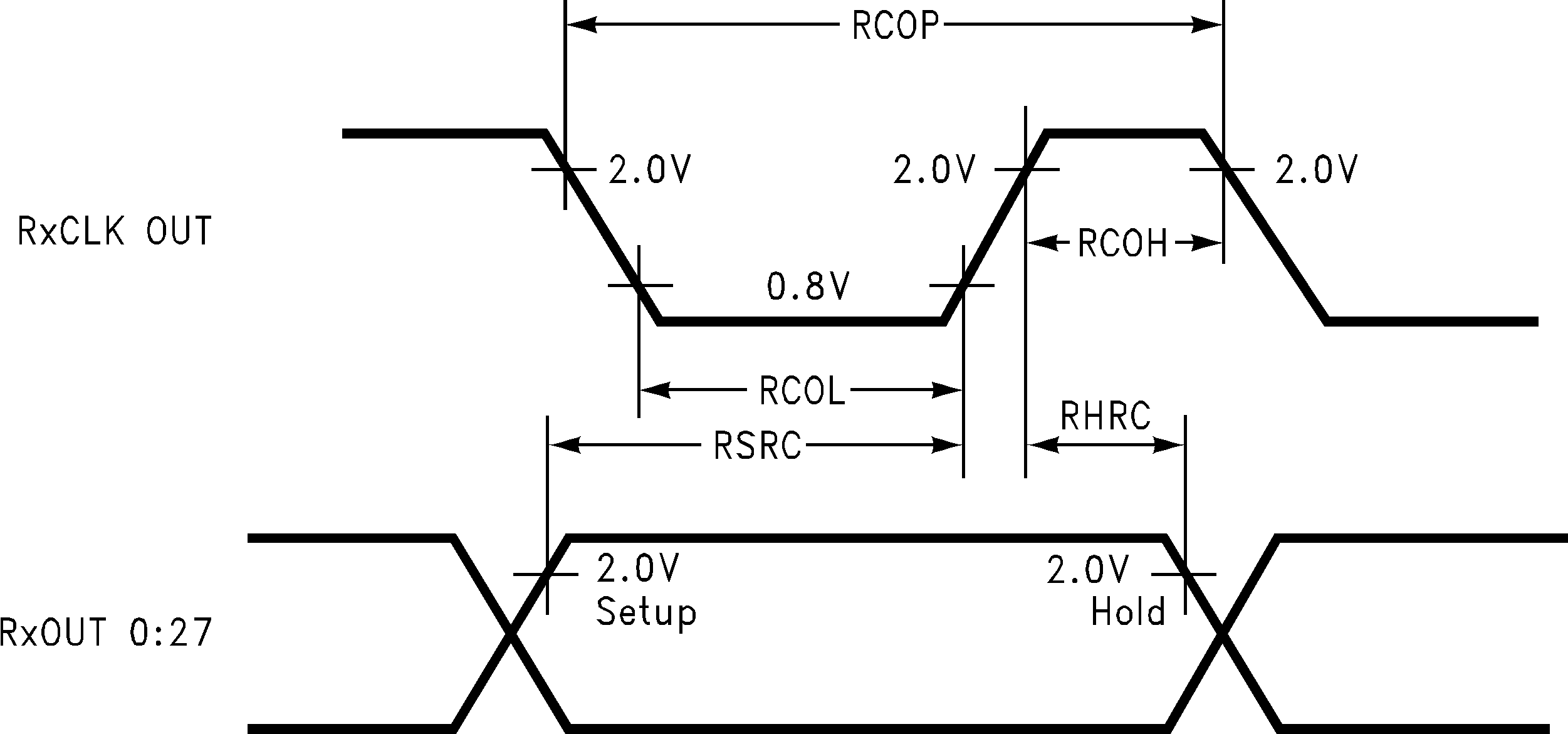 Figure 3. Setup/Hold and High/Low Times
Figure 3. Setup/Hold and High/Low Times
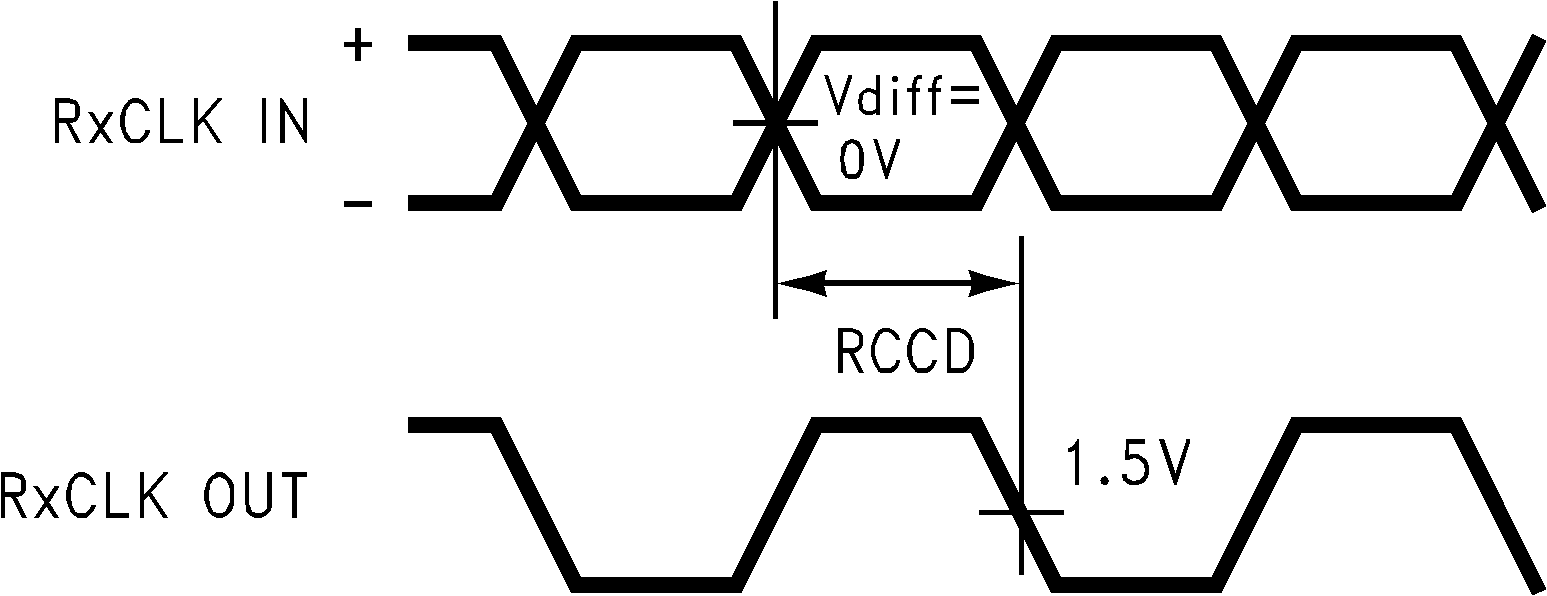 Figure 4. Clock In to Clock Out Delay
Figure 4. Clock In to Clock Out Delay
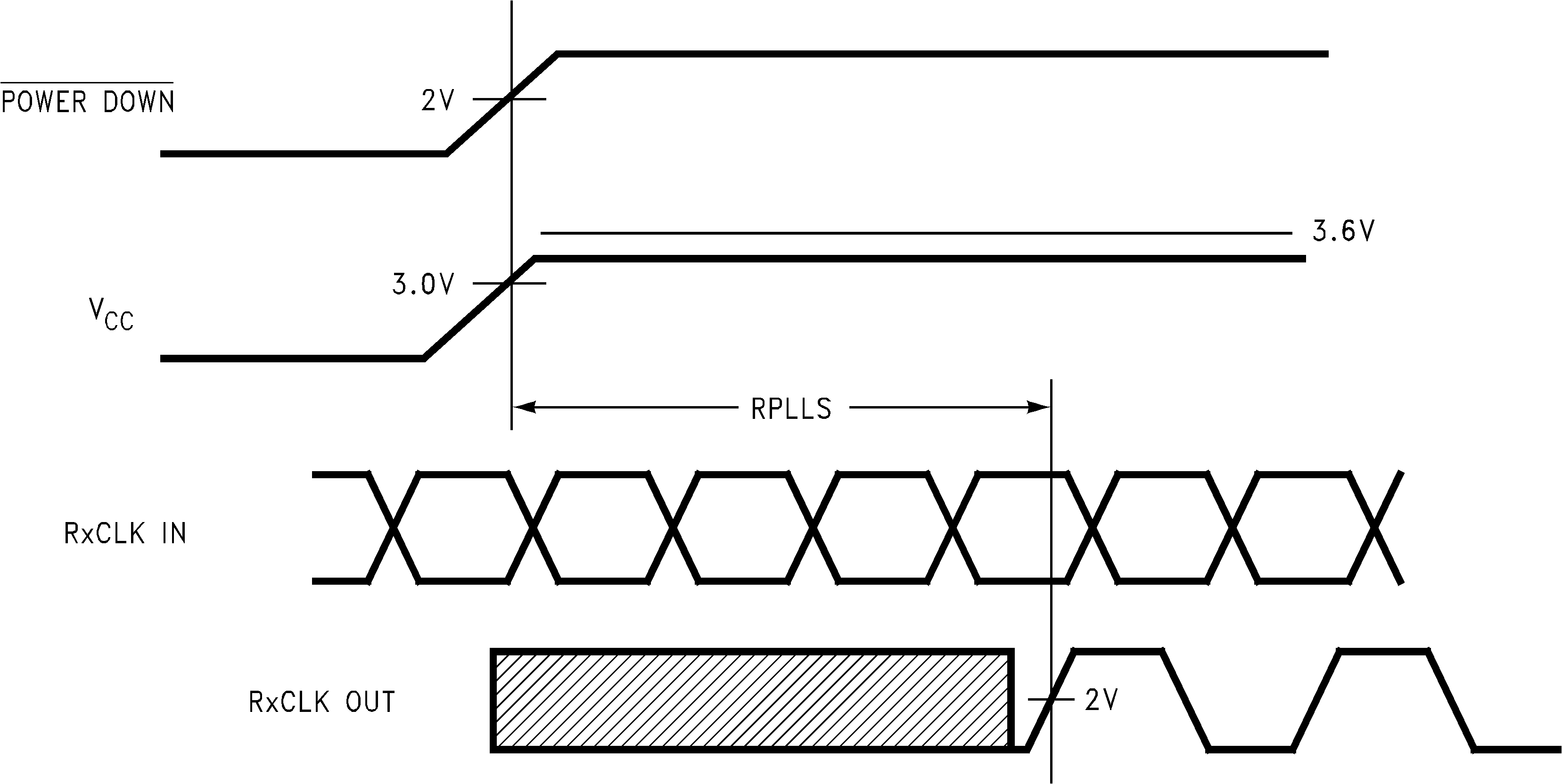 Figure 5. Phase Lock Loop Set Time
Figure 5. Phase Lock Loop Set Time
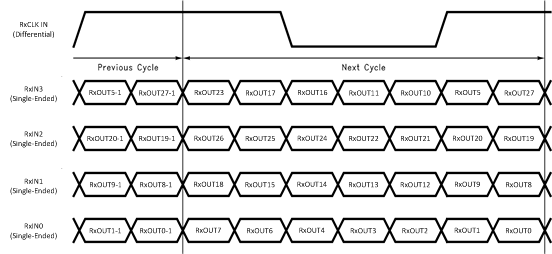 Figure 6. Mapping of 28 LVCMOS Parallel Data to 4D + C LVDS Serialized Data
Figure 6. Mapping of 28 LVCMOS Parallel Data to 4D + C LVDS Serialized Data
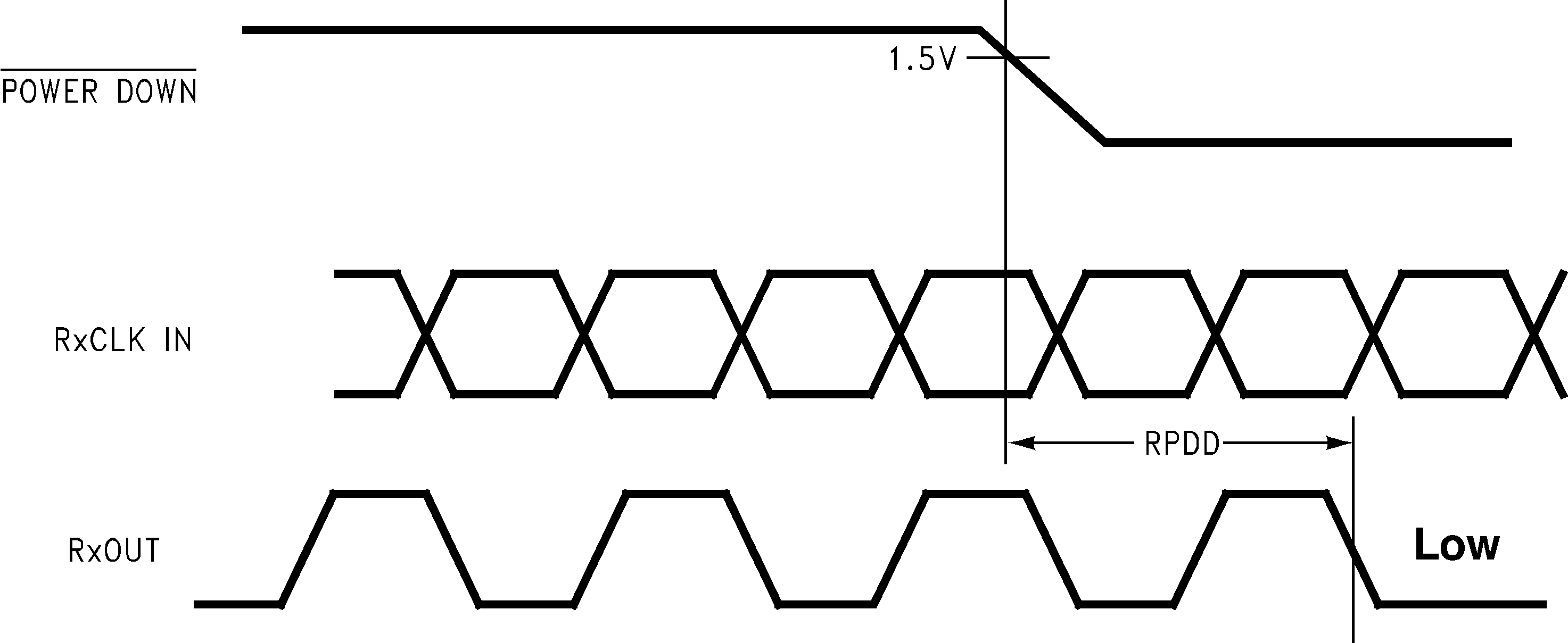 Figure 7. Power Down Delay
Figure 7. Power Down Delay
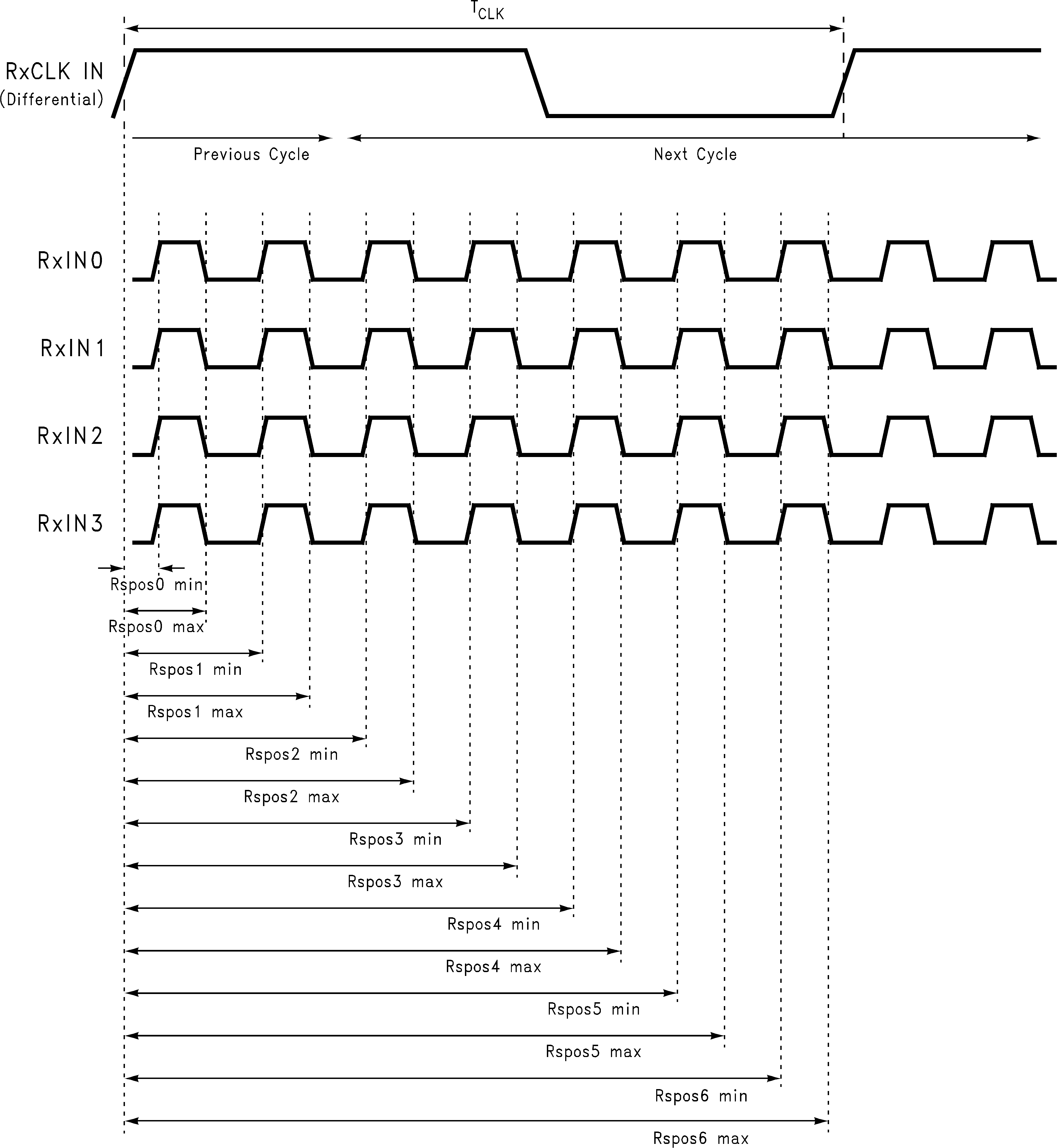 Figure 8. LVDS Input Strobe Position
Figure 8. LVDS Input Strobe Position
6.7 Typical Characteristics
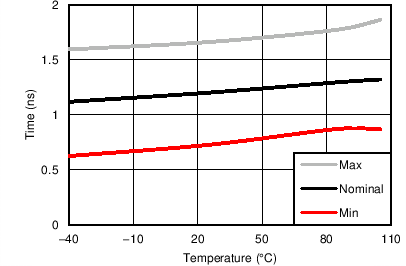 Figure 9. Rx Strobe Position 0 versus Temperature
Figure 9. Rx Strobe Position 0 versus TemperatureOperating Frequency: 66 MHz
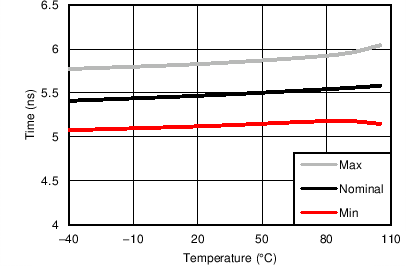 Figure 11. Rx Strobe Position 2 versus Temperature
Figure 11. Rx Strobe Position 2 versus TemperatureOperating Frequency: 66 MHz
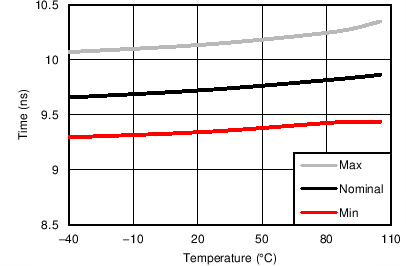 Figure 13. Rx Strobe Position 4 versus Temperature
Figure 13. Rx Strobe Position 4 versus TemperatureOperating Frequency: 66 MHz
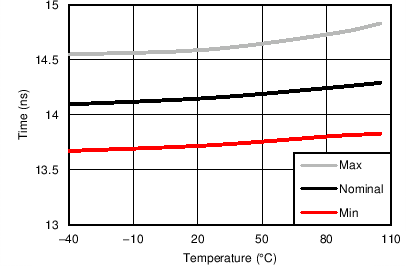 Figure 15. Rx Strobe Position 6 versus Temperature
Figure 15. Rx Strobe Position 6 versus TemperatureOperating Frequency: 66 MHz
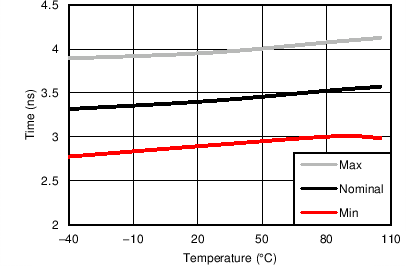 Figure 10. Rx Strobe Position 1 versus Temperature
Figure 10. Rx Strobe Position 1 versus TemperatureOperating Frequency: 66 MHz
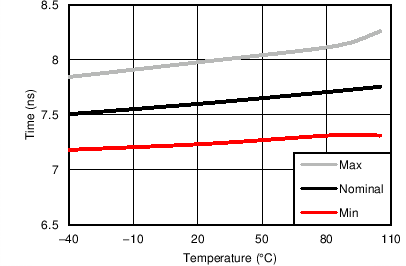 Figure 12. Rx Strobe Position 3 versus Temperature
Figure 12. Rx Strobe Position 3 versus TemperatureOperating Frequency: 66 MHz
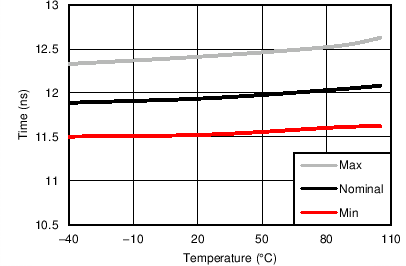 Figure 14. Rx Strobe Position 5 versus Temperature
Figure 14. Rx Strobe Position 5 versus TemperatureOperating Frequency: 66 MHz
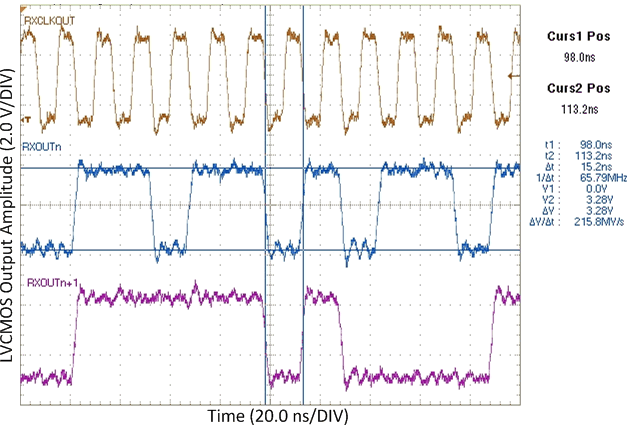 Figure 16. Parallel PRBS-7 on LVCMOS Outputs at 66 MHz
Figure 16. Parallel PRBS-7 on LVCMOS Outputs at 66 MHz
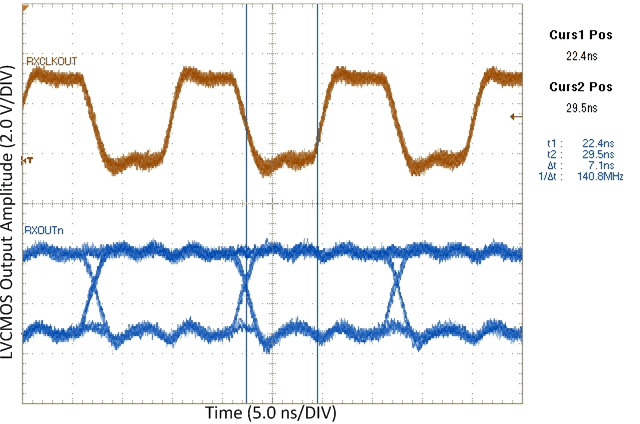 Figure 18. Typical RxOUT Setup Time at 66 MHz
Figure 18. Typical RxOUT Setup Time at 66 MHz (RSRC = 7.1 ns)
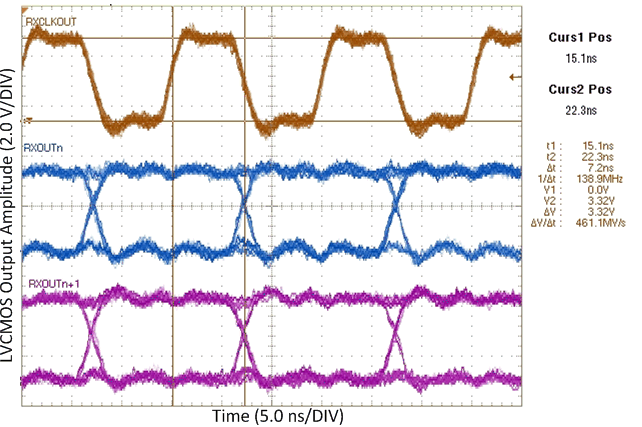 Figure 17. Typical RxOUT Timing Diagram at 66 MHz
Figure 17. Typical RxOUT Timing Diagram at 66 MHz
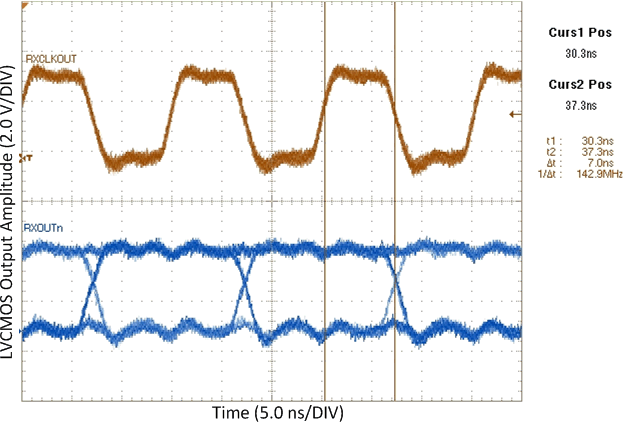 Figure 19. Typical RxOUT Hold Time at 66 MHz
Figure 19. Typical RxOUT Hold Time at 66 MHz (RHRC = 7.0 ns)